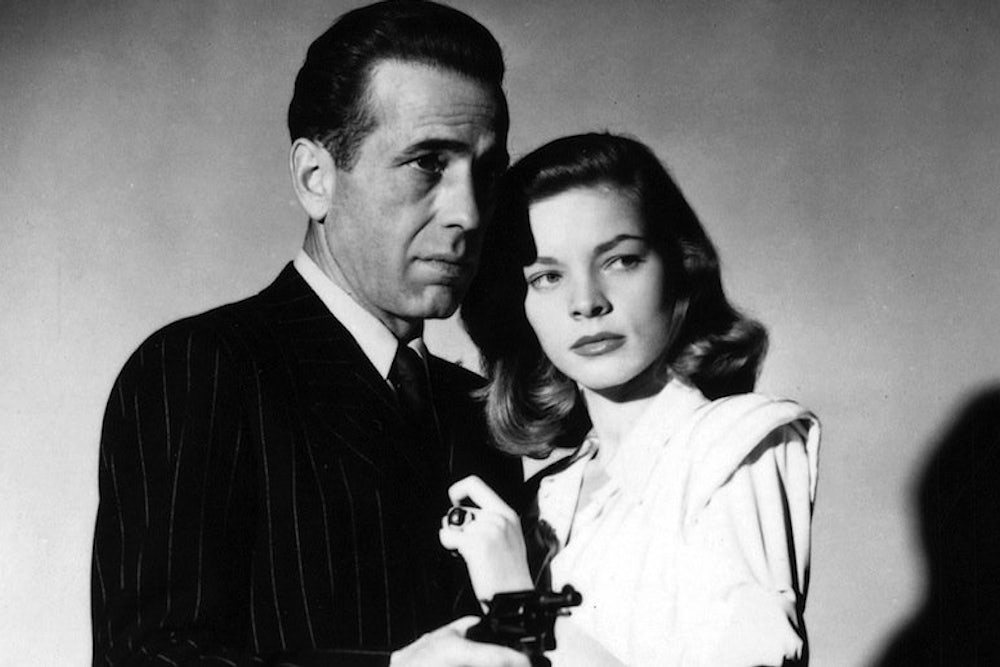The Big Sleep is an unsentimental, surrealist excitement in which most of the men in Hollywood's underworld are murdered and most of the women go for an honest but not unwilling private sleuth (Humphrey Bogart). Coinciding with the special prominence of the private detective in Hollywood movies, he has been tagged with the special name of "shamus." Lest there be friction between thieves and shamuses, script-writers have been equally thoughtful about holdup artists, so that their black deeds have been Disneyfied with the name "caper." The plot of The Big Sleep, which winds as crazily as a Greenwich Village street and involves so many secondary crimes and criminals that figuring it out makes you faint, starts with the underpaid shamus signing up to stop the blackmailing of a tough millionaire's depraved, thumbsucking daughter (Ann Vickers) by a dealer in pornographic books. That night two people you and the detective haven't seen before are murdered before they get a chance to show their faces on die screen and a six-year-old unsolved disappearance of an Irish patriot is brought to your already hysterical attention. The rest of the movie puts Bogart through some dozen more exotic and brutal situations until at the end, with unusually refreshing self-effacement, he admits he can tell the police just about all that happened.
There is a fantastic quality about all this excitement due to the apparent lack of integration between crimes, the sudden appearances of bizarre underworld figures and their more sudden, startling disappearances into the murky environment. It all has the feeling of an opium smoker's fantasy, and, incidentally, there's some of that in the film, too. With six murders in the plot, this nightmarish affair becomes less vital as you try to decide what motivates the people, whose chauffeur kills the inept blackmailer, who is having "the big sleep," who the perverted bookseller is—a foppish man with a mustache or a florid old man with a glass eye—what the exact relationship is between the widowed heiress and a classy gambler who operates a crime world by remote control. The Big Sleep, though, is witty and sinister, and in an odd way is a realistic portrayal of big-city life with Arabian Nights overtones. The detective's job takes him through Hollywood's underworld, which is made up of a classy crook whose cruelty is limitless, and a down-at-the-heel lot with comic faces and angelic souls. The chief impression you get of their world is that the pay is rotten, the people—especially the women—are uninhibited and no one lives to middle age. The locale is particularly seedy and pressed in on all sides by drab concrete. Gangster movies are increasingly coming to be stereotypes. Although the drab, blurred city streets are good, they are too familiar to be arresting. But far more than the usual skill is shown in the way the director (Howard Hawks) handles the human element. He is particularly adept in graphically suggesting voyeurism and other forms of sexuality without running afoul of the Johnston office.
The more inspired work occurs where the exotic subject matter is woven with straight naturalism—one of the best scenes has to do with the hiring of the detective by a tough millionaire. He is an aged individual who looks like a Southern general (writer William Faulkner may have been responsible for this) and who, after a life passionately devoted to pleasure, is living in a hothouse where he grows orchids. The scene is set up in such a super-realistic way it reminds you of an old-fashioned photograph. The Big Sleep would have been a more effective study of nightmarish existence had the detective been more complicated and had more curiosity been shown about his sweetheart's relation to the crime. Lauren Bacall, performing phlegmatically, creates a large empty space in the movie. Though Bogart turns in another jolting performance as well as some good comedy, his detective is a limited, dull person, who seems to have little sympathy with the sub-rosa world with which he must always be associated. A fine bit performance is turned in by Louis Jean Heydt as an incompetent crook who is fully aware of his shortcomings.
Other movies that are worth seeing are The Strange Love of Martha Ivers, The Killers and The Stranger.
This piece was originally published in The New Republic on September 23, 1946.
